The AMD 3rd Gen Ryzen Deep Dive Review: 3700X and 3900X Raising The Bar
by Andrei Frumusanu & Gavin Bonshor on July 7, 2019 9:00 AM EST** = Old results marked were performed with the original BIOS & boost behaviour as published on 7/7.
Benchmarking Performance: CPU Rendering Tests
Rendering is often a key target for processor workloads, lending itself to a professional environment. It comes in different formats as well, from 3D rendering through rasterization, such as games, or by ray tracing, and invokes the ability of the software to manage meshes, textures, collisions, aliasing, physics (in animations), and discarding unnecessary work. Most renderers offer CPU code paths, while a few use GPUs and select environments use FPGAs or dedicated ASICs. For big studios however, CPUs are still the hardware of choice.
All of our benchmark results can also be found in our benchmark engine, Bench.
Corona 1.3: Performance Render
An advanced performance based renderer for software such as 3ds Max and Cinema 4D, the Corona benchmark renders a generated scene as a standard under its 1.3 software version. Normally the GUI implementation of the benchmark shows the scene being built, and allows the user to upload the result as a ‘time to complete’.
We got in contact with the developer who gave us a command line version of the benchmark that does a direct output of results. Rather than reporting time, we report the average number of rays per second across six runs, as the performance scaling of a result per unit time is typically visually easier to understand.
The Corona benchmark website can be found at https://corona-renderer.com/benchmark
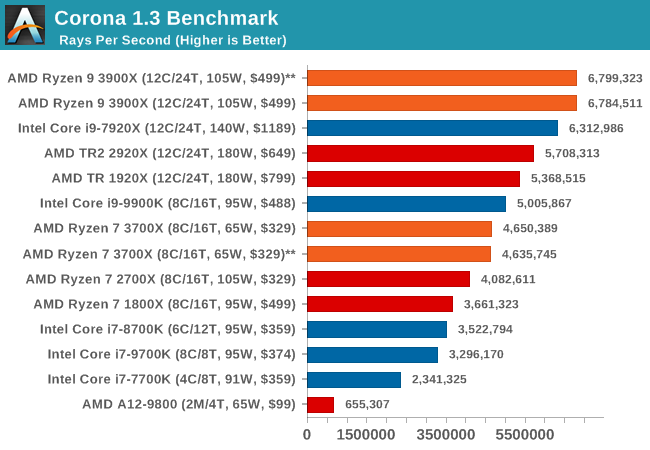
LuxMark v3.1: LuxRender via Different Code Paths
As stated at the top, there are many different ways to process rendering data: CPU, GPU, Accelerator, and others. On top of that, there are many frameworks and APIs in which to program, depending on how the software will be used. LuxMark, a benchmark developed using the LuxRender engine, offers several different scenes and APIs.

Taken from the Linux Version of LuxMark
In our test, we run the simple ‘Ball’ scene on both the C++ and OpenCL code paths, but in CPU mode. This scene starts with a rough render and slowly improves the quality over two minutes, giving a final result in what is essentially an average ‘kilorays per second’.

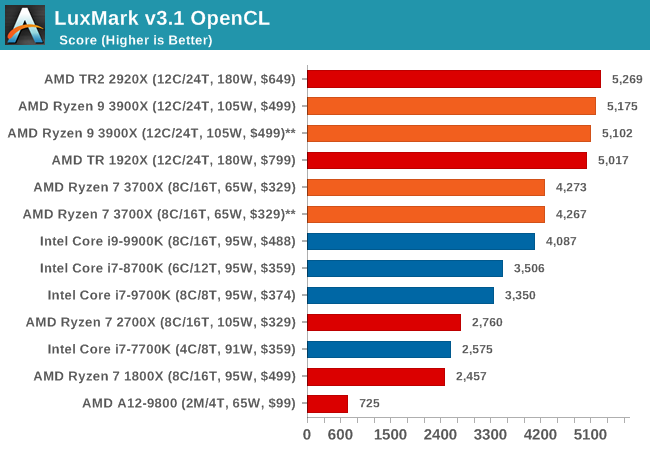
POV-Ray 3.7.1: Ray Tracing
The Persistence of Vision ray tracing engine is another well-known benchmarking tool, which was in a state of relative hibernation until AMD released its Zen processors, to which suddenly both Intel and AMD were submitting code to the main branch of the open source project. For our test, we use the built-in benchmark for all-cores, called from the command line.
POV-Ray can be downloaded from http://www.povray.org/
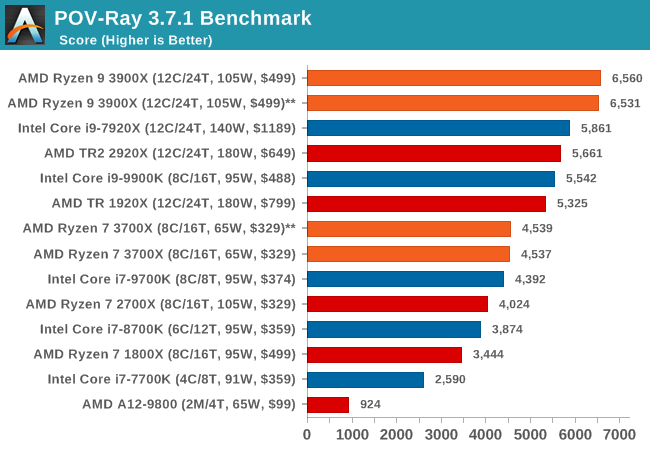
Cinebench R15
The latest version of CineBench has also become one of those 'used everywhere' benchmarks, particularly as an indicator of single thread performance. High IPC and high frequency gives performance in ST, whereas having good scaling and many cores is where the MT test wins out.
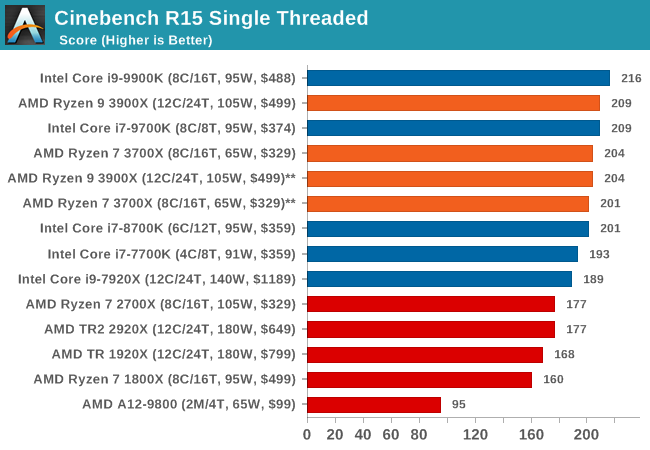
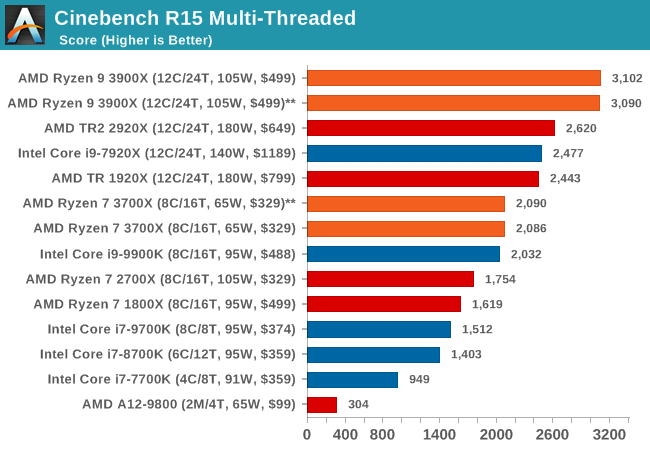











447 Comments
View All Comments
Tkan215 - Monday, July 8, 2019 - link
true the future is more cores. People and customers should feel awake that single core aint the future its just a stopping rock. more cores !Tkan215 - Monday, July 8, 2019 - link
yes i called it a tie because of the margin of error and patches were not taken into account. also, Intel get enormouse game support so really many factors as they are not equal playing groundwatzupken - Sunday, July 7, 2019 - link
Intel's bad moment just started. Clearly while there are some areas where Intel chips are still doing well, however the victories are significantly lesser now. Looking at the power metrics, they lost the fab advantage, so they are now in the disadvantage. To top it off, Intel is still charging monopolistic prices on their existing chips. Have not really seen the rumored price cuts, which may be too little and too late.StrangerGuy - Sunday, July 7, 2019 - link
IMO the $200 CPU landscape is now buy 3600 non-X, or get ripped off by Intel anything even if the latter for cheaper by $50.mikato - Thursday, July 11, 2019 - link
Yeah I really wish a 3600 was tested.Maxiking - Sunday, July 7, 2019 - link
Intel is waiting for 10nm, considering the fact AMD didn't even match Skylake prepatches performance... IF Intel fixes the 10nm, AMD will be be smashed to the ground. If it is a big if, but it is a fact.Mahigan - Sunday, July 7, 2019 - link
AMD actually beat Intel on a clock for clock basis now. What you're seeing is Intel's higher boost clocks saving the day (somewhat).If Intel can't go past 5GHz with their 10nm, due to the new core design, and only are able to get say 10-15% more performance per clock then Gen3 Ryzen will most likely end up, with its 7nm+ and improvements AMD aren't done making, in tough competition.
just4U - Sunday, July 7, 2019 - link
Intel won't be doing any smashing anytime soon there Max.. I was damn pleased with the overall value/performance of my 2700x in comparison to my highly overclocked 8700K (4.9Ghz) and basically shrugged of the 9 series intel. The addition of a 12core.. with great performance levels really changes the game.Even if Intel brings something out it's not going to destroy anything. All we've seen over the past 5 years is small bumps upwards in performance.
Korguz - Sunday, July 7, 2019 - link
Maxiking intel has been waiting for 10nm for 204 years now.. and they are still kind of waiting for it. skylake prepatch ? as in specture and meltdown ? um.. kind of need those fixes/patches in place, even if it means a performance hit.. but by all means.. get skylake, dont fix/patch it, and worry about that.. and spend more.. its up to you... either way.. zen2.. looks very good....Targon - Monday, July 8, 2019 - link
What RAM was used in the Intel system? The Ryzen system used DDR4-3200, but it's CL16, not CL14 RAM. That CAS latency difference would be enough for Ryzen to at least tie the 9900k if not beat it in the gaming tests.